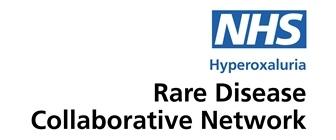
What is Hyperoxaluria?
Hyperoxalurias are rare kidney disorders due to disorders of oxalate and glyoxylate. Although these disorders are actually due to either liver enzymes (primary hyperoxaluria) or gastrointestinal disorders (secondary hyperoxaluria), the effects are seen in the kidneys because that is where oxalate is excreted. Oxalate is very insoluble in urine and so precipitates out, causing kidney stones, kidney calcification (nephrocalcinosis) and chronic kidney disease which can sometimes lead to end-stage renal disease (kidney failure). This may require treatment with dialysis and/or transplantation which in the case of some primary hyperoxalurias would require both liver and kidney transplantation to be successful.
For background information, please see Patient Information (https://ukkidney.org/rare-renal/patient/hyperoxaluria) and Clinician information on the UK Kidney Association website. This has been peer reviewed and is regarded as the official resource for hyperoxaluria for the UK patient, carer and professional community.
What is the Hyperoxaluria RDCN?
The Hyperoxaluria Rare Disease Collaborative Network (RDCN) was set up in February 2021. We are clinicians and active clinical researchers in hyperoxaluria disorders. We also contribute at European level (via OxalEurope – the European clinicians/scientists grouping, and ERKNet - an EU programme that we were part of until 2020). This is the first RDCN in the renal community.
What is the aim of the RDCN?
Our aim is to improve diagnoses and patient outcomes in hyperoxaluria, across the UK. There are already expert groups of patients (PH Europe, Metabolic Support UK, OHF), clinicians/scientists (OxalEurope), registries (RADAR and OxalEurope), drug oversight (NICE). Our plan is to work together with all of these groups and any other colleagues, to co-ordinate and avoid duplication of work.
How are we funded?
At the moment, we aren’t! All RDCN members are currently doing this work in their own time. This is not ideal and seriously limits what we can achieve. We hope that having national visibility will encourage funding from partner organisations, including industry partners. Our ultimate aim is to become an NHS Highly Specialised Service, perhaps with other rare kidney stone disorders such as cystinuria. Unlike RDCNs, Highly Specialised Services are funded by the NHS. There are many overlaps in terms of clinical expertise and high cost drugs. We are therefore modelling our work programme in the same way: clinical service, pathways and patient feedback. We think that this will be the best outcome for patients, the NHS and for drug development.
How are we going to achieve our aims?
We have set ourselves three initial objectives.
Objective 1: Creation of a virtual clinical pathway which is nationally available
Clinicians at our specialist centres are already used to being consulted informally by colleagues elsewhere. We propose setting up a videoconference MDT to discuss diagnosis, management and trial participation with other clinicians. We can use this to create or test out clinical guidelines for future siRNA drug prescription. It will also make it easier to facilitate paediatric to adult transition between units.
Later, we will use this experience to create a virtual clinical diagnostic pathway, elements of which could be accessed by patients or interested clinicians. This is important in diagnosing rare diseases where patients often become experts faster than their clinicians and we would strongly encourage patient involvement in this.
Objective 2: We can help the NHS use new and high-cost drugs in a cost-effective way
Two new siRNA drugs (a new technology allowing long-term knockdown of a gene product) are being trialled at all of our hospital sites. Lumasiran (Alnylam) has already received UK marketing authorisation, and nedosiran (Dicerna) is following closely. These new drugs are a game-changer in hyperoxaluria, but will no doubt be very expensive, so will need clinical and financial oversight. We propose that our videoconference MDT could be used as a specialist MDT to agree criteria (in advance of national criteria) and make joint treatment decisions. Other drugs are expected soon in enteric hyperoxaluria.
There is a potential further opportunity in that liver transplantation, an expensive and scarce resource, could be reduced to some extent by the siRNA drugs, if they are used in the correct way. Estimation of cost/benefit and health economic measures would rely on data obtained from appropriate close patient monitoring via a national system. A good example would be the prevention of end-stage renal disease by judicious use of expensive complement inhibitor drugs (https://www.atypicalhus.co.uk), thereby reducing the need for kidney replacement therapy.
Objective 3: Making genetic testing quicker and easier
Primary hyperoxalurias are genetic disorders and the diagnosis can be confirmed easily in most cases by sequencing of up to three genes. The new NHS Genomic Medicine Service aims to create national referral systems for genetic tests and patient reviews. We will work with our geneticist colleagues to build a co-ordinated system so that clinicians can access testing quickly and efficiently. We will assist this process by clarifying criteria for genetic testing, ensuring that all patients are seen by an expert clinician, and that clinical data are safely stored in the national RADAR database.
How do I refer a patient for testing or specialist advice?
Patients should be referred by nephrologists or other secondary care clinician to the RDCN. We can then involve their nearest specialist centre or provide advice as needed.
Contact Dr Shabbir Moochhala:

Centre leads
Shabbir Moochhala, Royal Free Hospital (adult) and national RDCN Lead
Graham Lipkin, University Hospitals Birmingham (adult)
Lavanya Kamesh, University Hospitals Birmingham (adult)
Sally Hulton, Birmingham Children’s Hospital (paediatric)
Asheeta Gupta, Birmingham Children’s Hospital (paediatric)
Detlef Bockenhauer, Great Ormond Street Hospital (paediatric)
Wesley Hayes, Great Ormond Street Hospital (paediatric)
Some RDCN group members are also members of the Rare Disease Group for hyperoxaluria (https://ukkidney.org/rare-renal/patient/hyperoxaluria-0).
Written by Dr Shabbir Moochhala, on behalf of the Hyperoxaluria RDCN
October 2021